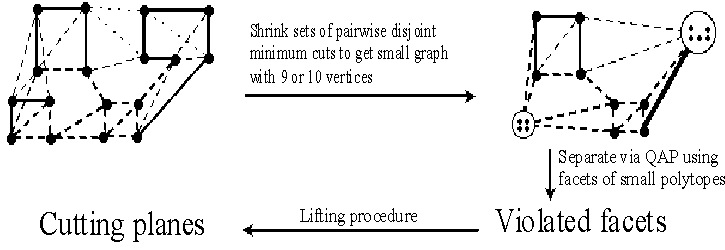Discrete and
Combinatorial Optimization
The TSPSIR project
Background
- idea: use known polytopes associated with small combinatorial
optimization problems for cutting plane separation procedures
- SIR is an approach to tighten LP relaxations in branch-and-cut
exploiting known outer descriptions of small polytopes
- SIR stands for Small Instance Relaxation
Motivation
- finding facet defining cutting planes is crucial in the successful
optimal solution of TSP instances via branch-and-cut
- the SIR approach works for the TSP
- outer desciptions of low-dimensional symmetric TSP polytopes known
(computable by PORTA,
facet database here)
- possible to find facet defining cutting planes when other procedures (comb, clique-tree, ...) fail
Steps
- shrink several pairwise disjoint minimum cuts of a TSP support
graph to get a small TSP support graph
- use known outer descriptions of small TSP polytopes associated with
small problems for separation with small support graph
- lift found small facets of outer descriptions of small polytopes
to get cutting planes for original problem

Problems
- compute and choose sets of minimum cuts of TSP support graph
so that shrunken graphs have a predefined order
- often there is a vast amount of shrinking possibilities; choose most
promising shrunken graphs for time-consuming separation
- separation for small graphs is done via an NP-hard Quadratic Assignment
Problem and solved heuristically
- number of facets is too large even for small polytopes
to check them all in a brute-force manner
Contribution
- we succeeded in generating all promising shrinking possibilities
by representing all minimum cuts via a cactus
- a sophisticated use of the cactus allows to complete this generation
within seconds; a former more naive attempt took hours
- for many TSP support graphs we can compute many facet defining
cuts after other separation procedures failed
- research and experiments are ongoing; emphasis is on picking
most promising shrunken graphs and parts of the vast facet pool
Details
|
Research Group Discrete Optimization
|

